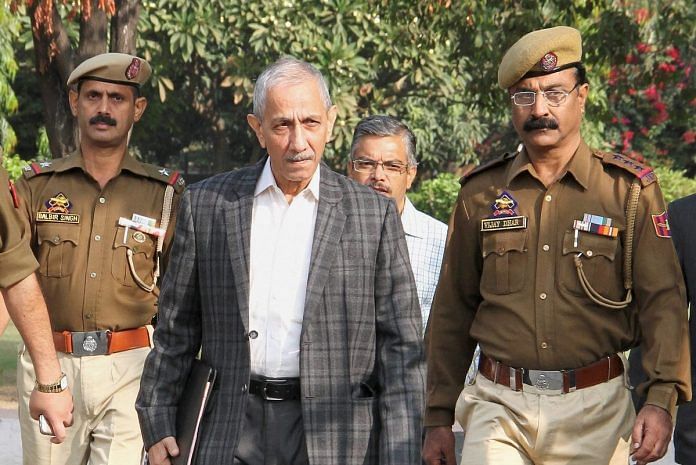The separatist challenge can be overcome to a certain extent if Sharma can convince the civil society of the sincerity of his efforts.
The government of India’s ‘special representative’ for Kashmir, Dineshwar Sharma, has recently completed his first visit to the Valley. There are the usual sceptics about the usefulness of this dialogue, based on the experience of past interlocutors, but in my view this is a significant step forward. It is an acknowledgment that conflict resolution in Jammu and Kashmir has to move beyond the narrow prism of gauging success by the number of terrorists killed and stone-pelting incidents tackled.
Obviously, not too much was expected from this visit as it would have been exploratory in nature to get a feel of the sentiment in both Kashmir and Jammu regions. Sharma met a number of delegations but there were also important groups who chose to keep away. However, the ice has been broken, and as the Governor suggested, dialogue must be sustained.
Sharma has a huge task cut out in front of him. It is extremely difficult to find a quick and permanent solution to a problem that has vexed the nation since its independence. It may, therefore, have to be taken up in phases. The first step is to bring calm to the streets of Kashmir by an outreach to the people, particularly the youth. If images of Kashmiri mobs attacking the security forces continue to flash on the TV screens, it will drown out the voices for peace. Under pressure from a vocal majority, the government will find it troublesome to negotiate.
Ted Robert Gurr, in his article, ‘Minorities, Nationalists and Islamists: Managing Communal Conflict in the Twenty-First Century’, writes that three types of incentives prompt political action (including violence) by identity groups, “resentment about losses suffered in the past, fear of future losses, and hopes for relative gains”. All these incentives are present in the current conflict that is playing out in the state of Jammu and Kashmir, and these are not only limited to the Kashmir Valley. Shades of this are present both in Jammu and Ladakh. These are the issues that Dineshwar Sharma must look to address in his future interactions and subsequent recommendations to the government.
Assuage the past resentment built up in the almost three-decade long conflict, give confidence that social and cultural sensitivities will be protected, and finally inculcate hope that there will be conflict resolution based on the democratic principles enshrined in the Indian Constitution.
The separatists ruled out any talks stating: “In principle, the pro-freedom leadership has always advocated and supported sincere and productive dialogue as a means of conflict resolution over Jammu and Kashmir. It entails all participants to acknowledge that there is a dispute that has to be resolved. But the GoI continuously refuses to accept this basic premise.”
Sharma has said that he will “try his best” to meet the separatist leaders. In my view the Hurriyat will not come to the table. With their hardened stance during the 2016 protests, heightened ethnic activism in which they played on the fears of a loss of the Kashmiri identity and culture, and a strong pro-Pakistan approach, the separatists have somewhat painted themselves in a corner. Coming out of this corner will be at a heavy cost, both to their ideological stance as well as public support.
This separatist challenge can be overcome to a certain extent if Sharma can convince the civil society of the sincerity of his efforts. Obviously, this is no easy task but I strongly feel that civil society in the state has a huge role to play. There is a lot of talk of radicalisation taking place, and this is a matter of concern, but there is a more worrisome trend — an easy acceptance of violence in the society.
Young soldiers, policemen and political workers are pulled out of their homes and murdered. Anybody who resists has his home burned down, not by terrorists, but local villagers. A 70-year-old man is stoned to death by ordinary people on the mere suspicion of being a braid-chopper. A brutalisation of society is unfolding.
A reversal of this trend will require the combined efforts of all civil society groups in the state, and a healing touch from New Delhi, applied through the efforts of Dineshwar Sharma.
Another group which must come together in its support of the special representative is the political class. David A. Lake and Donald Rothchild in a scholarly work titled Containing Fear: The Origins and Management of Ethnic Conflict, have brought out that, “Politicians in the middle of the political spectrum or those who court ethnically heterogeneous constituencies are vulnerable… to political extremists seeking to draw electoral support from only a more ethnically homogeneous and possibly more militant constituency…Even centrist politicians can be driven to embrace a more ‘ethnic’ position and defend communal interests more vigorously, a phenomenon often referred to as ethnic outbidding.”
This temptation will have to be avoided.
The author retired as General Officer Commanding-in-Chief of the Indian army’s Northern Command.



